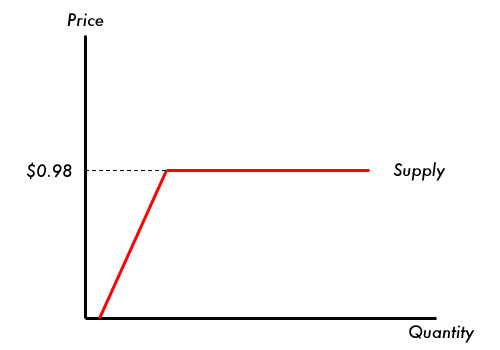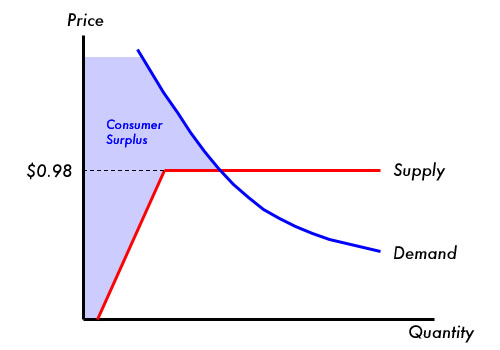But this isn't about Barenaked Ladies. It's about Amie Street, an online music store that just started offering their new album. Like the much better known iTunes Store run by Apple, Amie Street sells music over the web. Amie Street is very much unlike the iTunes Store, however, in two key regards. First, the music is DRM-free, which may or may not be important to you. If you know what DRM stands for, it probably is.
Even more interesting, however, is Amie Street's pricing structure. While 99 cents per song is pretty much the industry standard, all music on Amie Street starts out entirely free. That's right, free. But only to the first customers through the door. As more customers show up to buy a particular song, the price increases gradually, maxing out at 98 cents.
Sound like a revolutionary business plan? It is, and here's why. I've seen a variety of selling strategies before: artists giving away music for free, letting buyers name the price, etc. But Amie Street is unique in the way its pricing structure has the potential to benefit both listeners and artists.
It's all about surplus. Surplus, in economics, is essentially a measure of how well someone made out at the negotiation table. In the world of buyers and sellers, there are always buyers who feel they got a great deal, and sellers pleased with the amount they squeezed out of the buyers. Say the negotiated price for a record is $10. If the buyer went to the table willing to pay $13, then his surplus is $3 - the amount he was willing to shell out but didn't have to. If the seller, on the other hand, would have gone as low as $7 before walking away, then her surplus is also $3 - the amount she got paid above what she was willing to accept. Equilibrium, in the classic sense, is the point at which both sides feel they got a fair deal, but nothing to brag about.
What's revolutionary about Amie Street is the way its model hands all the surplus over to the buyers. Here's a graph of the classic version of supply and demand, with shaded areas showing the surplus:

Amie Street's model is different. While I don't know exactly how many songs they will sell at a given price, I imagine their supply curve looks something like this:

Even at a price of $0, Amie Street will sell some number of songs. As the quantity sold rises, though, so does the price. Once the price hits 98 cents, the supply curve plateaus. Why? Because at that price, Amie Street will sell to however many buyers come along. The final sales figure is entirely dependent on demand. The profit is the same for each additional song sold at full price, and Amie Street shares the bulk of the wealth with the artist (70% according to the website).
The interesting stuff happens among the buyers. Barenaked Ladies are a popular group; overall demand is pretty high. Within hours of their new songs appearing on Amie Street, the price had climbed to the full 98 cents on all but a few, and all were selling for the maximum price after only a day. The lucky few who bought early made out like bandits: some paid nothing, while many others surely paid far less than they would have otherwise. All that surplus ended up in the buyers' pockets. Amie Street sold each song for exactly what it was willing to accept; there was no surplus whatsoever on the supply side. The graph now looks like this:

All that blue makes for happy buyers.
So that's an illustration of how Amie Street's business model benefits consumers. But why would any rational seller give away all that surplus? Wouldn't Amie Street and the artists who sell on the site make more money if they just started the price at 98 cents? Heck, why not charge twice as much when songs first come out to take advantage of the ardent fans who want the new material as soon as possible no matter what the cost? Turn all that blue to red, and capture the surplus for the seller.
That might work for some artists, especially the most popular ones with the largest fan base. But for others - particularly relative unknowns - Amie Street's model has the potential to grow their market and reap greater rewards in the long run.
See, Amie Street's pricing structure encourages early adoption. That is, by dangling the carrot of free downloads, they encourage buyers to seek out and discover new music. Not everything is guaranteed to be good, but diamonds in the rough certainly stand a better chance of being found. Like a song but don't love it? You might not be willing to shell out 98 cents, but a dime? Sure! It might even grow on you over time, so you recommend it to a friend, who might also like it enough to buy it at a lower price. If the product is good enough, this process repeats, and the fan base grows.
Lots of artists rely on word of mouth to expand their audience, but Amie Street gives them the potential to accelerate the process. It's hard to imagine the obstacles between buyer and seller being lowered much further than offering free downloads over the web; all it takes is a little initiative to bridge the gap. Amie Street's supply curve is always the same, but as the audience grows, demand grows, and the demand curve shifts.

The greater the demand, the higher the sales. Higher sales means more money for both Amie Street and the artist. With enough success, the surplus given away by the seller may be entirely recouped.
If the product is good enough, an artist might ultimately find its songs selling for full price, without any of the marketing and production costs typically spent by major labels. The costs of distribution through Amie Street are almost entirely marginal (per unit rather than a large fixed sum), so it is easier for artists to get their music into the market. Even for Amie Street much of the cost of operation is marginal; bandwidth in particular is a perfect example of a marginal cost.
My gut reaction when I first read about Amie Street was that it was another marketing gimmick. But the more I think about it, the more I think they're re-writing the rules of the music industry. For years there have been questions about the long-term viability of making music, and there have been plenty of losses along the way. Amie Street might have on its hands a practical solution that pleases both buyers and sellers simultaneously. If it catches on, it might be leading a revolution.



1 comment:
very interesting article - glad to have found it thru being in the same boingboing post yesterday as you - harmony, Andy
Post a Comment